 Hyundai Elantra AD: Forward Collision Avoidance (FCA) System
Hyundai Elantra AD: Forward Collision Avoidance (FCA) System
The Forward Collision-Avoidance Assist (FCA) system is designed to help detect and monitor the vehicle ahead in the roadway through camera recognition to warn the driver that a collision is imminent, and if necessary, apply emergency braking.
The camera type FCA system detects the vehicle ahead in the roadway through camera.
WARNING
Take the following precautions when using the Forward Collision- Avoidance Assist (FCA) system:
- This system is only a supplemental system and it is not intended to, nor does it replace the need for extreme care and attention of the driver. The sensing range and objects detectable by the sensors are limited. Pay attention to the road conditions at all times.
- Drive at posted speed limits and accordance to road conditions.
- Always drive cautiously to prevent unexpected and sudden situations from occurring. The Forward Collision- Avoidance system may not always stop the vehicle completely and is only intended to help mitigate a collision that is imminent.
System Setting and Activation
System setting

• Setting Forward Safety function
The driver can activate the FCA by placing the ignition switch to the ON position and by selecting:
'User Settings → Driver Assistance → Forward Safety'
- If you select "Active Assist", the FCA system activates. The FCA produces warning
messages and warning alarms in accordance with the collision risk levels. Braking
assist will be applied in accordance with the collision risk.
- If you select "Warning Only", the FCA system activates and produces only warning
alarms in accordance with the collision risk levels. Braking assist will not be
applied in this setting.
- If you select "Off", the FCA system deactivates,

The warning light illuminates on the LCD display, when you cancel the FCA system. The driver can monitor the FCA ON/OFF status on the LCD display. Also, the warning light illuminates when the ESC (Electronic Stability Control) is turned off. If the warning light remains ON when the FCA is activated, have the system checked by an authorized HYUNDAI dealer.

• Setting Warning Timing
The driver can select the initial warning activation time on the LCD display.
Go to the 'User Settings → Driver Assistance → Warning Timing → Normal/Later'.
The options for the initial Forward Collision Warning includes the following:
- Normal :
When this option is selected, the initial Forward Collision Warning is activated sensitively. If you feel the warning activates too early, set the Forward Collision Warning to 'Later'.
Even though, 'Normal' is selected if the front vehicle suddenly stops the initial warning activation time may not seem fast.
- Later :
When this option is selected, the initial Forward Collision Warning is activated later than normal. This setting reduces the amount of distance between the vehicle ahead before the initial warning occurs.
Select 'Later' when traffic is light and when driving speed is slow.
Information
If you change the warning timing, the warning time of other systems may change. Always be aware before changing the warning timing.
Prerequisite for activation
The FCA system is on and ready when 'Active Assist' or 'Warning Only' under Forward Safety is selected in the LCD display and when the following prerequisites are satisfied:
- The ESC (Electronic Stability Control) is on.
- Driving speed exceeds approximately 6mph (10 km/h) (The FCA is only activated
within a certain speed range.).
- The system detects a vehicle in front, which may collide with your vehicle. (The
FCA may not be activated or may sound a warning alarm in accordance with the driving
situation or vehicle condition.)
WARNING
- FCA automatically activates upon placing the ignition switch to the ON position. The driver can deactivate FCA by canceling the system setting in the cluster LCD display. To avoid driver distractions, do not attempt to set or cancel the FCA while driving the vehicle.
- FCA automatically deactivates upon canceling ESC. When ESC is canceled, FCA cannot be activated in the cluster LCD display. The FCA warning light will illuminate which is normal.
FCA Warning Message and Brake Control
FCA produces warning messages, warning alarms, and emergency braking based on the level of risk of a frontal collision, such as when a vehicle ahead suddenly brakes.
Collision Warning (First warning)
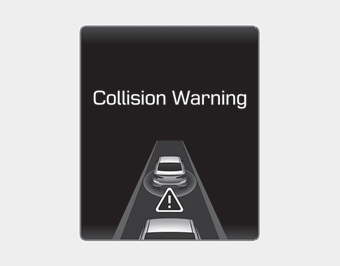
This warning message appears on the LCD display with a warning chime. Additionally, some vehicle system intervention occurs by the engine management system to help decelerate the vehicle.
- Your vehicle speed may decelerate moderately.
- The FCA system limitedly controls the brakes to preemptively mitigate impact in
a collision.
- If you select "Warning Only", the FCA system activates and produces only warning
alarms in accordance with the collision risk levels.You should control the brake
directly because the FCA system do not control the brake.
Emergency Braking (Second warning)
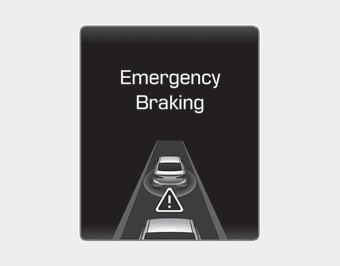
This warning message appears on the LCD display with a warning chime.
Additionally, some vehicle system intervention occurs by the engine management system to help decelerate the vehicle.
- The FCA system limitedly controls the brakes to preemptively mitigate impact
in a collision. The brake control is maximized just before a collision.
- If you select "Warning Only", the FCA system activates and produces only warning
alarms in accordance with the collision risk levels.You should control the brake
directly because the FCA system do not control the brake.
Brake operation
- In an urgent situation, the braking system enters into the ready status for prompt reaction against the driver's depressing the brake pedal.
- The FCA provides additional braking power for optimum braking performance, when the driver depresses the brake pedal.
- The braking control is automatically deactivated, when the driver sharply depresses the accelerator pedal, or when the driver abruptly operates the steering wheel.
- The FCA braking control is automatically canceled, when risk factors disappear.
CAUTION
- The driver should always use extreme caution while operating the vehicle, whether or not there is a warning message or alarm from the FCA system.
- After the brake control is activated, the driver must immediately depress the brake pedal and check the surroundings. The brake activation by the system lasts for about 2 seconds.
- If any other warning sound such as seat belt warning chime is already generated, the Forward Collision- Avoidance Assist (FCA) system warning may not sound.
- Playing the vehicle audio system at high volume may prevent occupants from hearing the system warning sounds.
WARNING
The FCA braking control cannot completely stop the vehicle nor avoid all collisions. The driver should hold the responsibility to safely drive and control the vehicle.
WARNING
The FCA system logic operates within certain parameters, such as the distance from the vehicle ahead, the speed of the vehicle ahead, and the driver's vehicle speed. Certain conditions such as inclement weather and road conditions may affect the operation of the FCA system.
WARNING
Never deliberately drive dangerously to activate the system.
FCA Sensor
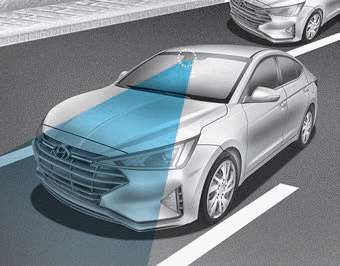
In order for the FCA system to operate properly, always make sure the camera is clean and free of dirt, snow, and debris.
Dirt, snow, or foreign substances on the sensor cover or sensor may adversely affect the sensing performance of the sensor.
NOTICE
- NEVER install any accessories or stickers on the front windshield, or tint the front windshield.
- NEVER place any reflective objects (i.e. white paper, mirror) over the crash pad. Any light reflection may prevent the system from functioning properly.
- Pay extreme caution to keep the camera dry.
- NEVER disassemble the camera assembly, or apply any impact on the camera assembly.
- If the sensor is forcibly moved out of proper alignment, the FCA system may not operate correctly. In this case, a warning message may not be displayed. Have the vehicle inspected by an authorized HYUNDAI dealer.
Information
Have the system checked by an authorized HYUNDAI dealer when:
- The windshield glass is replaced.
Warning message and warning light
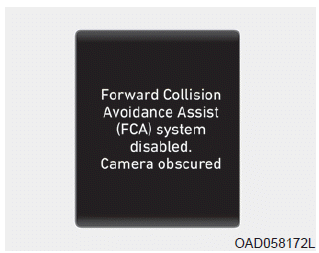
Forward Collision Avoidance Assist (FCA) system disabled. Camera obscured
When the front camera is blocked with dirt, snow, or debris, the FCA system operation not be able to detect other vehicles. If this occurs, a warning message will appear on the LCD display. The system will operate normally when such dirt, snow or debris is removed.
FCA may not properly operate in an area (e.g. open terrain) where any objects or vehicles are not detected after turning on the engine.
System Malfunction

Check Forward Collision Avoidance Assist system
- When FCA is not working properly, the FCA warning light (
 )
will illuminate and the warning message will appear for a few seconds. After
the message disappears, the master warning light (
)
will illuminate and the warning message will appear for a few seconds. After
the message disappears, the master warning light ( )
will illuminate. In this case, have the vehicle inspected by an authorized HYUNDAI
dealer.
)
will illuminate. In this case, have the vehicle inspected by an authorized HYUNDAI
dealer. - The FCA warning message may appear along with the illumination of the ESC (Electronic Stability Control) warning light.
Both FCA warning light and warning message will disappear once the ESC warning light issue is resolved.
WARNING
- FCA is only a supplemental system for the driver's convenience. It is the driver's responsibility to control the vehicle operation. Do not solely depend on the FCA system. Rather, maintain a safe braking distance, and, if necessary, depress the brake pedal to reduce the driving speed or to stop the vehicle.
- In certain instances and under certain driving conditions, the FCA system may activate prematurely. This initial warning message appears on the LCD display with a warning chime. Also due to sensing limitations, in certain situations, the front camera recognition system may not detect the vehicle ahead. The FCA system may not activate and the warning message may not be displayed.
- If there is a malfunction with the FCA system, the Forward Collision avoidance assist system is not applied even though the braking system is operating normally.
- If the vehicle in front stops suddenly, you may have less control of the brake system. Therefore, always keep a safe distance between your vehicle and the vehicle in front of you.
- The FCA system may activate during braking and the vehicle may stop suddenly shifting loose objects toward the passengers. Always keep loose objects secured.
- The FCA system may not activate if the driver applies the brake pedal to avoid collision.
- The brake control may be insufficient, possibly causing a collision, if a vehicle in front abruptly stops. Always pay extreme caution.
- The FCA system may not activate according to the road conditions, inclement weather, driving conditions or traffic conditions.
- Occupants may get injured, if the vehicle abruptly stops by the activated FCA system. Pay extreme caution.
- The FCA system does not detect all vehicles.
WARNING
- The FCA system operates only to detect vehicles in front of the vehicle.
- The FCA system does not operate when the vehicle is in reverse.
- The FCA system is not designed to detect other objects on the road such as animals.
- The FCA system does not detect vehicles in the opposite lane.
- The FCA system does not detect cross traffic vehicles that are approaching.
- The FCA system cannot detect the driver approaching the side view of a parked vehicle (for example on a dead end street).
In these cases, you must maintain a safe braking distance, and if necessary, depress the brake pedal to reduce the driving speed in order to maintain a safe distance or to stop the vehicle.
Limitations of the System
The Forward Collision Avoidance Assist (FCA) system is designed to monitor the vehicle ahead on the roadway through camera recognition to warn the driver that a collision is imminent, and if necessary, apply emergency braking.
In certain situations, the camera may not be able to detect the vehicle ahead. In these cases, the FCA system may not operate normally. The driver must pay careful attention in the following situations where the FCA operation may be limited.
Detecting vehicles
The sensor may be limited when:
- The camera is blocked with a foreign object or debris
- Inclement weather such as heavy rain or snow obscures the field of view of the camera
- There is interference by electromagnetic waves
- The vehicle is on unpaved or uneven rough surfaces, or road with sudden gradient changes.
- The vehicle drives through a construction area, on an unpaved road, or above metal materials, such as a railway
- The vehicle in front is too small to be detected (for example a motorcycle or a bicycle, etc.)
- The camera's field of view is not well illuminated (either too dark or too much reflection or too much backlight that obscures the field of view)
- The camera does not recognize the entire vehicle in front.
- The vehicle in front is an oversize vehicle or trailer that is too big to be detected by the camera recognition system (for example a tractor trailer, etc.)
- The vehicle in front does not have rear lights or the rear lights are not turned ON or the rear lights are located unusually.
- The outside brightness changes suddenly, for example when entering or exiting a tunnel
- The vehicle is moving underground level or inside a building
- The vehicle drives inside a building, such as a basement parking lot
- The adverse road conditions cause excessive vehicle vibrations while driving
- You are on a roundabout and the vehicle in front circles
- The camera lens is contaminated due to tinted, filmed or coated windshield, damaged glass, or stuck of foreign matter (sticker, bug, etc.) on the glass
- The camera is damaged.
- The brightness outside is too low such as when the headlamps are not on at night or the vehicle is going through a tunnel.
- Light coming from a street light or an oncoming vehicle is reflected on a wet road surface such as a puddle in the road
- The field of view in front is obstructed by sun glare
- The shadow is on the road by a median strip, trees, etc.
- The vehicle drives through a tollgate.
- The windshield glass is fogged up; a clear view of the road is obstructed
- The camera sensor recognition is limited
- The rear part of the vehicle in front is not normally visible (for example, the vehicle is spinning or the vehicle is overturned)
- The sensor recognition changes suddenly when passing over a speed bump
- The vehicle in front is driving erratically
- The vehicle in front is moving vertically to the driving direction
- The vehicle in front is stopped vertically
- The vehicle in front is driving towards your vehicle or reversing
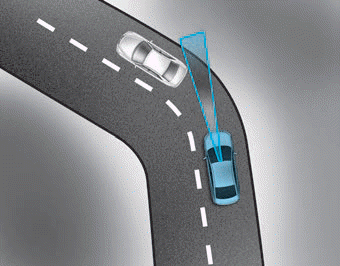
• Driving on a curve
The performance of the FCA system may be limited when driving on a curved road.
In certain instances on a curved road, the FCA system may activate prematurely.
Also, in certain instances the front camera recognition system may not detect the vehicle traveling on a curved road.
In these cases, the driver must maintain a safe braking distance, and if necessary, depress the brake pedal to reduce your driving speed in order to maintain a safe distance.

The FCA system may recognize a vehicle in the next lane when driving on a curved road.
In this case, the system may unnecessarily alarm the driver and apply the brake.
Always pay attention to road and driving conditions, while driving. If necessary, depress the brake pedal to reduce your driving speed in order to maintain a safe distance.
Also, when necessary depress the accelerator pedal to prevent the system from unnecessarily decelerating your vehicle.
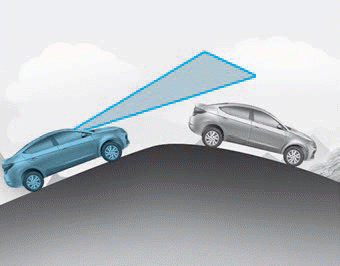
• Driving on a slope
The performance of the FCA decreases while driving upward or downward on a slope, not recognizing the vehicle in front in the same lane. It may unnecessarily produce the warning message and the warning alarm, or it may not produce the warning message and the warning alarm at all.
When the FCA suddenly recognizes the vehicle in front while passing over a slope, you may experience sharp deceleration.
Always keep your eyes forward while driving upward or downward on a slope, and, if necessary, depress the brake pedal to reduce your driving speed in order to maintain distance.

• Changing lanes
When a vehicle changes lanes in front of you, the FCA system may not immediately detect the vehicle, especially if the vehicle changes lanes abruptly. In this case, you must maintain a safe braking distance, and if necessary, depress the brake pedal to reduce your driving speed in order to maintain a safe distance.
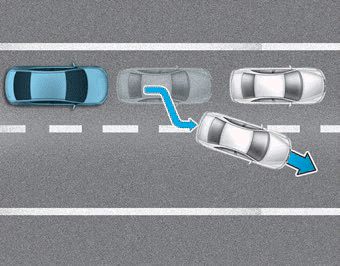
When driving in stop-and-go traffic, and a vehicle in front of you merges out of the lane, the FCA system may not immediately detect the new vehicle that is now in front of you. In this case, you must maintain a safe braking distance, and if necessary, depress the brake pedal to reduce your driving speed in order to maintain a safe distance.
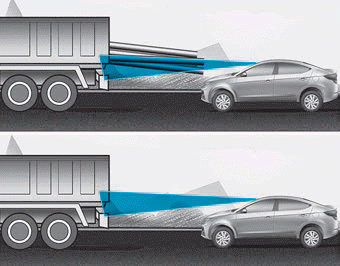
• Detecting the vehicle in front of you
If the vehicle in front of you has cargo that extends rearward from the cab, or when the vehicle in front of you has higher ground clearance, additional special attention is required. The FCA system may not be able to detect the cargo extending from the vehicle. In these instances, you must maintain a safe braking distance from the rearmost object, and if necessary, depress the brake pedal to reduce your driving speed in order to maintain distance.
Information
In some instances, the FCA system may be canceled when subjected to electromagnetic interference.
Information
This device complies with Part 15 of the FCC rules.
Operation is subject to the following two conditions:
1. This device may not cause harmful interference.
2. This device must accept any interference received, including interference that may cause undesired operation.
WARNING
- Do not use the Forward Collision Avoidance Assist (FCA) system when towing a vehicle. Application of the FCA system while towing may adversely affect the safety of your vehicle or the towing vehicle.
- Use extreme caution when the vehicle in front of you has cargo that extends rearward from the cab, or when the vehicle in front of you has higher ground clearance.
- The FCA system is designed to detect and monitor the vehicle ahead in the roadway through camera recognition. It is not designed to detect pedestrians, bicycles, motorcycles, or smaller wheeled objects such as luggage bags, shopping carts, or strollers.
- Never try to test the operation of the FCA system. Doing so may cause severe injury or death.


